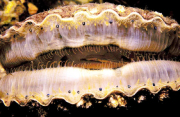Posted on OA: 27 Feb 2014

Nanaimo-based Island Scallops has shut down its processing plant and laid off a third of its workforce.
Ten million scallops that have died in the waters near Qualicum Beach due to rising ocean acidity are the latest victims in a series of marine die-offs that have plagued the West Coast for a decade.
Human-caused carbon dioxide emissions in the atmosphere are being absorbed by the ocean and may have pushed local waters through a “tipping point” of acidity beyond which shellfish cannot survive, according to Chris Harley, a marine ecologist at the University of B.C.
Rising ocean acidity is a global phenomenon, made worse by higher natural acidity in local waters, Harley said.
“I’ve seen pH measured down to about 7.2, so this is very much within the realm of possibility, though unfortunate and extreme,” he said. “We are in a hot spot in the Pacific Northwest.”
The lower the pH, the higher the acidity. Local waters are typically a much-less-acidic 8.2.
High acidity interferes with the ability of baby scallops to form a protective shell, forcing them to expend more energy and making them more vulnerable to predators and infection.
“When the pH goes down, it’s a lot harder to build that shell and we’ve seen that in a lot of other species in the lab,” said Harley. “It interferes with everything they do, their basic physiology is affected.”
Nanaimo-based Island Scallops has shut down its processing plant and laid off 10 people, almost one third of its workforce. The company is a marine hatchery and scallop producer with more than 500 hectares in production.
That’s about 16 per cent of B.C.’s total shellfish culture.
Acidity and carbon dioxide concentrations are measured daily at the hatchery and in the ocean, said Rob Saunders, company CEO.
“In 2009 we started to notice significant problems in the hatchery and when we communicated with hatcheries in Washington, they were seeing the same thing,” he said. “Suddenly we were getting these low pH values. pH has been so stable that for a lot of years no one bothered to measure it, because it never changed. It was really startling.”
Scallop operations big and small are reporting die-offs this year. Mysterious scallop die-offs have also been reported in China since 1996.
Oyster die-offs in Washington state and Oregon dating back a decade have also been linked by National Oceanic and Atmospheric Administration researchers to acidification and rising carbon dioxide levels.
Oyster larvae started dying inexplicably in 2005. Researchers found that deep water welling up from the depths of the ocean was mixing with surface water rich in carbon dioxide from the atmosphere, rendering the water uninhabitable to some shellfish.
Atmospheric carbon dioxide recently passed 400 parts per million in the Earth’s atmosphere, according to recent measurements taken at the Mauna Loa Observatory. That’s up from 280 ppm in the pre-industrial era.
It’s a phenomenon that Saunders has also noticed.
Carbon dioxide concentrations that had been stable for as long as records were kept started to climb and, rather than correcting, they stayed high. By 2011, concentrations were verging on double the normal range, he said.
Randy Shore, Vancouver Sun, 25 February 2014. Article.